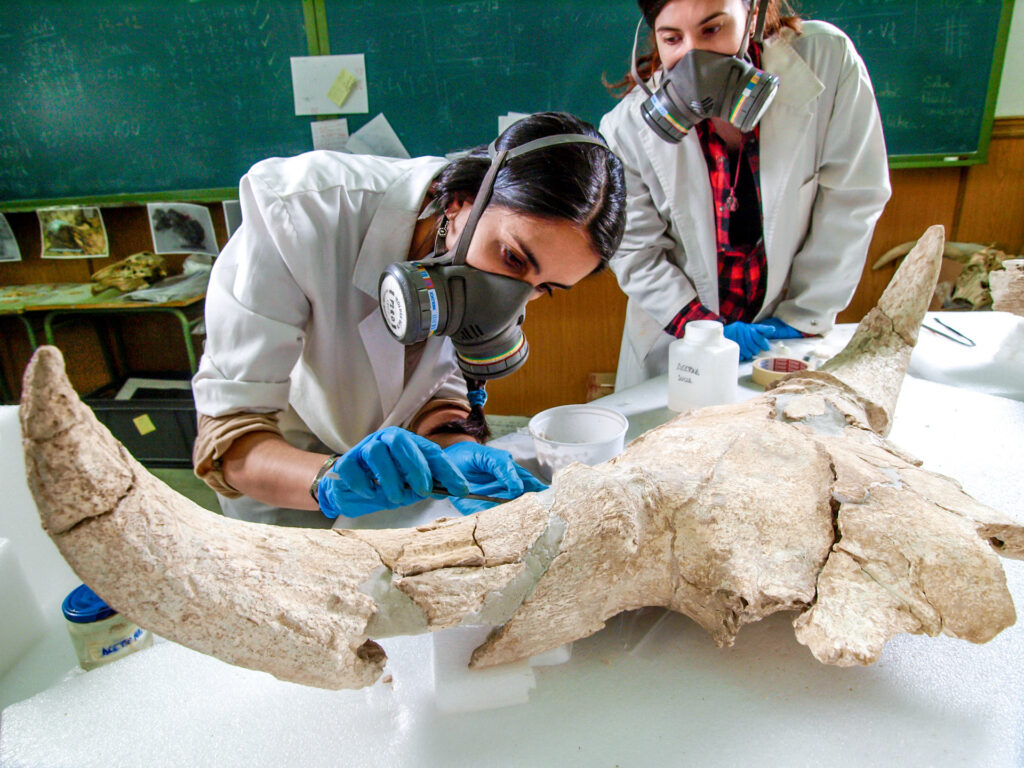Ana Abrunhosa, researcher at the Interdisciplinary Center for Archeology and Evolution of Human Behavior (ICArEHB) at the University of Algarve (UAlg) and archaeologist at the National Research Center for Human Evolution (CENIEH), is part of the research team that has just published an article in the journal Nature Human Behaviour, confirming that Neanderthals had symbolic capabilities.
Analysis of the skulls of large herbivores found at the site of the Des-Cubierta cave (Pinilla del Valle, Madrid) reveals that these hominins, who lived in the region more than 40 years ago, used them as hunting trophies.
The study is led by the three co-directors of the research team: archaeologist Enrique Baquedano, paleontologist Juan Luis Arsuaga and geologist Alfredo Pérez-González.
The skulls found at this hunting sanctuary, including those of bison (bison priscus), aurochs (Bos primigenius), deer (Cervus elaphus) and two rhinos of the species Stephanorhinus hemitoechus they were prepared by Neanderthals following the same pattern: they removed the mandible and the upper jaw, consuming the brain, and leaving the part of the skull with the horns or antlers as a hunting trophy.
«We were able to confirm that the activity was maintained for at least several generations, which introduces the concept of cultural tradition that would have been passed from generation to generation», explains paleontologist from the Complutense University Juan Luis Arsuaga, one of the authors of this article in which they also participated researchers from CENIEH, the University of Valladolid (Uva), the Complutense University of Madrid (UCM) and the National Museum of Natural Sciences of Madrid (MNCN-CSIC).
Together with these skulls, Mousterian lithic tools, typical of Neanderthals, were found, as well as anvils and the hammers used to fracture them. The raw materials used were of local origin and very varied (flint, quartzite, gneiss, etc.).
«The Neanderthals who explored them knew how to take advantage of each raw material, adapting their technology and needs to the material available, demonstrating that they did not depend on a specific type of rock to develop their technology and daily activities», explains Ana Abrunhosa.
This behavior is not related to subsistence activities but to others that provide information about aspects of Neanderthals that are largely unknown.
"Until now, our species had been considered the only one able to attribute concepts to symbols, a theory that, based on these discoveries, obliges us to share this intellectual attribute with the Neanderthals", says Enrique Baquedano, director of the Archaeological Museum and Paleontological Community of Madrid.
«This study opens the door to a new concept of this species of hominin and questions our role as the only sapiens in the evolution of life on the planet», says Juan Luis Arsuaga.
The Cueva Des-Cubierta site is a long gallery of caves with fallen roofs, that is, without their original roof, in which an exceptional collection of skulls of large herbivores has been recovered, some of them associated with small bonfires.
To date, throughout the territory where the species Homo neanderthalensis distributed, there is no other archaeological site similar to Pinilla del Valle. The discoveries of Cave Des-Cubierta make it an exceptional place that allows to unveil the keys to the behavior of this species that coexisted with the Homo sapiens.



















Comments